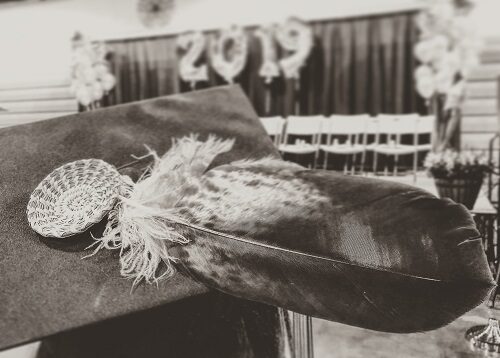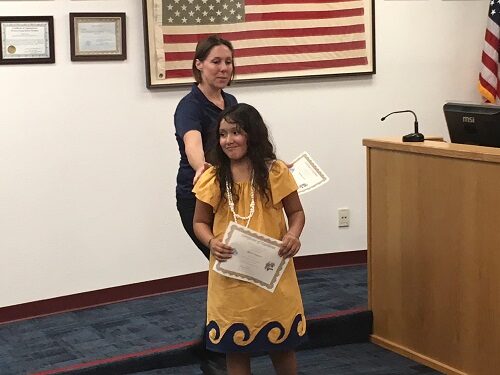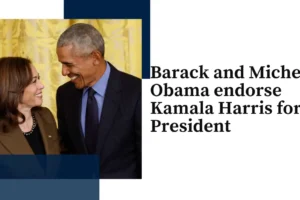Gov. Doug Ducey signed a bill yesterday into law that ensures that Arizona high school students may wear tribal regalia and culturally significant items during their graduation ceremony.
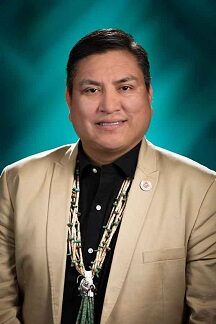
Arlando Teller, deputy assistant secretary for Tribal Affairs for the U.S. Dept. of Transportation
HB 2705, sponsored by former Rep. Arlando Teller, prohibits school district governing boards, charter school governing bodies and any public school from establishing a dress code policy that prevents students who are members of a federally recognized Indian tribe or who is eligible to be enrolled as a member of a federally recognized Indian tribe from wearing traditional tribal regalia or objects of cultural significance, including an eagle feather or eagle plume, at a graduation ceremony.
House Bill 2705 was carried forward by Rep. Myron Tsosie after Teller was appointed to be the deputy assistant secretary for Tribal Affairs for the U.S. Dept. of Transportation by President Joe Biden. The Senate gave a due pass recommendation to HB 2705 with 24 ayes – 6 nays – and 0 not voting on April 13.
The bill grew from a 2019 discussion when Teller “and I heard from Gila River Indian Community Gov. (Stephen Roe) Lewis, who reached out to us and informed us several schools had banned students from wearing traditional regalia during their graduation ceremony,” said Rep. Tsosie, when the bill was introduced to the House Education Committee meeting on Feb. 2, 2021.
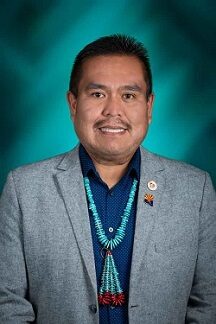
Rep. Myron Tsosie
In 2019, LaRissa Waln, a member of the Sioux tribe and a graduating senior at Valley Vista High School in Surprise, was turned away from her high school graduation ceremony after trying to enter State Farm Stadium wearing a cap adorned with a traditional feather and beads and refusing to wear an offered plain cap and gown with her traditional clothing underneath, The Arizona Republic reported. Waln and her family then protested outside the graduation ceremony.
Bryan Waln, LaRissa’s father, said he asked school and district officials for an exception on a religious and cultural basis, but was denied. A school district statement said, “Our district is disappointed that this situation occurred, especially after the school discussed the expectations and met with the family in advance in an effort to resolve their concerns and offer alternative options.”
“To us as Native Americans, our traditional regalia tells the family we come from, our history, our culture. It also identifies us as an individual – the traditional necklaces, the bracelets, the rings that we wear along with the clothing that we wear when we dress traditionally helps us identify ourselves to the holy people,” Rep. Tsosie said. “For that reason, we encourage our students to wear their traditional attire during this sacred ceremony when they walk across the stage during graduation.”
High school graduates at Salt River Schools are encouraged to adorn their caps and gowns with Indigenous pride. Photo courtesy Salt River Schools
“As a school system within a sovereign nation the Salt River Pima-Maricopa Indian Community Salt River Schools is proud to say we have always encouraged our students to honor their cultures and traditions, whether within the daily curriculum or at milestone events like graduation,” said Taté Walker, Salt River Schools communications and public relations director.
“We love seeing everything from eagle feathers and beaded caps to shell necklaces and regalia,” said Walker, a Mniconjou Lakota and a citizen of the Cheyenne River Sioux Tribe of South Dakota.
“We want the education system to reflect and embrace our students’ whole selves, especially their Indigenous identities, because we know the powerful impact it has on academic and social outcomes,” Walker said.
“We are also thrilled to see other schools in Arizona take this small, easy step in the direction of honoring Indigenous students, who too often are made to feel like their cultures and languages are unwelcome in educational spaces,” Walker said.
8th grade promotion in 2019. Photo courtesy Sacaton ESD
“We can’t wait to see all the creative, colorful, and culturally-significant ways the class of 2021 and beyond choose to highlight their Indigeneity,” Walker said.
Ar Sacaton Elementary School District, which serves many students from the Gila River Indian Community, all staff members encourage students to wear their tribal attire for all special occasions such as Governing Board presentations, 8th grade promotion, Native Studies and more, said Supt. Dr. Cherryl Paul.
“All Sacaton employees contribute to strengthening learner confidence. One of the pathways is to reinforce to students how fortunate they are to have a rich heritage,” Dr. Paul said. “We prepare students to give back to their community through service projects and honoring self, family, and community.”
Brandon celebrates high school graduation. Photo courtesy Salt River Schools.
While many school districts have policies and dress codes for graduation ceremonies, most high school principals will meet with students and their families to discuss and consider their requests and the school’s expectations.
“We encourage all Sacaton students to take ownership of their learning, embrace their culture and live our vision statement. We take pride in personal, academic, and cultural development and pursue life-long learning with excellence while advocating for our himthag,” Dr. Paul said.
“Dysart appreciates the desire of students to honor cultural traditions, and does allow graduates to wear traditional tribal regalia or objects of cultural significance at a graduation ceremony, along with a cap and gown, in accordance with our dress code,” said Renée Ryon at Dysart Unified School District. “Our principals are happy to meet with anyone regarding our graduation dress code.”
“At Dysart, we are proud of each and every one of our graduates, and can’t wait to see what the future holds for them. We understand that graduation is an exciting time, and our goal is to ensure each student is appropriately recognized for successfully graduating high school,” Ryon said.
Prescott High School Principal Mark Goligoski said he’s only had one incidence where a student asked to wear an item of cultural significance during the graduation ceremony.
“They only asked to wear the feather. We allowed them to wear the feather in their tassel,” Goligoski said. “We do as much as we can to be compassionate about it.”
Graduates are encouraged to adorn their caps and gowns with Indigenous pride. Photo courtesy Salt River Schools
“The general rule is during the ceremony everybody just does the cap and gown, and then if they want anything extra – it doesn’t matter if it’s tribal or a lot of them will go get the leis – we just say bring it, keep it underneath and then you can wear it later,” Goligoski said.
Now, that the legislation has been signed into law, “We’re 100% supportive of that,” Goligoski said.
The important thing is to have the conversations with the students, Goligoski said.
“Anyway that we can still set some parameters for what our expectations are, but at the same time be sensitive to folks culturally as well as their religious beliefs, we try to have those conversations, collaborate with the community and make sure we’re doing it in a respectful manner,” Goligoski said. “I think that’s just the key with everything that we do.”
Don Johnson, an attorney who advises school districts, said at that meeting, “The concern I want to share about this bill is the scope of the prohibition. The bill prohibits districts from dress codes that prohibit any items of cultural significance. I think we’re opening the door to a lot of unintended consequences with that.”

Gila River Indian Community Gov. Stephen Roe Lewis
Then Meghaen Dell’Artino, owner of Public Policy Partners Government Relations, read a statement provided by Gila River Indian Community Gov. Stephen Roe Lewis that said, “This legislation is important to the Gila River Indian Community and all Arizona Tribes as public and charter schools across the state are inconsistent in how they treat the wearing of regalia which creates uncertainty and frustration for our tribal students.”
“High school graduation should be a time of celebration for graduates, their families and their tribe,” Gov. Lewis said in the statement.
” At a time when the graduation rate of Native Americans in Arizona hovers around 67%, lower than the 77% average of non-Indian students nationally, graduation is a milestone that should be acknowledged by the entire community,” Gov. Lewis said.

A student wearing tribal regalia during graduation. Photo courtesy Casa Grande Union High School District
“When milestones occur, it is customary for tribal communities to acknowledge the significance of the achievement by awarding eagle feathers, beading significant items worn to graduation, or as is the case with the Gila River Indian Community by presenting each graduating member with an honorary stole to be worn during the graduation ceremony,” Gov. Lewis said in the statement.
“Wearing tribal regalia during graduation doesn’t take anything away from the other graduates, nor does it distract from the ceremony,” Gov. Lewis said.
“I’ve been told of some cases where some schools have allowed graduates to adorn their graduation outfits with writings or money leis during the ceremony all the while denying our graduates the right to wear culturally significant regalia,” Gov. Lewis said.
“Our graduating students shouldn’t be forced to give up their culture on a day when it should be honored,” Gov. Lewis said in the statement.
Casa Grande Union High School Principal Brian Mabb said students at Vista Grande High School and Casa Grande Union High Schools, which serve many students who are part of the Gila River Indian Community, may wear tribal regalia and items of cultural significance during their graduation ceremonies.
A student presents to the Governing Board. Photo courtesy Sacaton ESD
“The elders of the Nation present stoles to our Native American graduates to wear with their caps and gowns,” Mabb said. “A representative of the tribe usually contacts the school to determine the best time to meet the students (usually before or after graduation practice) to present them with their gift.”
“It is important to them and their families that their cultural heritage should be celebrated. It also brings awareness to those who may not be familiar with Native American culture,” Mabb said.
In addition, the school district also hosts the Graduation Pow Wow to recognize our Native American Graduates annually at Casa Grande Union High School, Mabb said.

Sen. Jamescita Peshlakai
Before Sen. Jamescita Peshlakai, the state’s first Native American woman senator, voted aye during the Senate Floor Session on April 13, 2021, she thanked former state representative former Rep. Teller for bringing the bill forward.
Sen. Peshlaki is Diné, Navajo, of the Tangle People clan, born for the Red House clan. Her maternal grandfathers are the Bitter Water clan, and her paternal grandfathers are the Cliff Dweller clan.
She represents Legislative District 7, which spans seven counties with most constituents members of the Navajo Nation, Hualapai, Havasupai, Kaibab Paiute, San Juan Southern Paiute, Hopi, White Mountain Apache, San Carlos Apache and a small portion of Zuni Pueblo tribes.
“I wish to congratulate all the 2021 graduates and hope that they are all able to wear their Native American outfits and traditional clothes to graduation this year,” Sen. Peshlakai said.

Casa Grande Union High School students wearing tribal regalia during their graduation ceremony. Photo courtesy Casa Grande Union High School District











